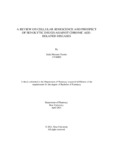A review on cellular senescence and prospect of Senolytic drugs against chronic age-related diseases

View/
Date
2021-04Publisher
Brac UniversityAuthor
Tasnim, Saida MasumaMetadata
Show full item recordAbstract
Cellular senescence can be described as a condition in which dividing of the cells stops permanently and undergo distinctive epigenetic modifications, including profound chromatin and secretory changes, resulting in the formation of senescent cells. Senescent cells accumulate in multiple tissues throughout the course of ageing and the formation of excessive senescent cells in various tissues results in numerous chronic disorders, tissue degradation, age-related diseases, and ageing of organs. This indicates that the removal of senescent cells can minimize ageing and thus serves as a potential target for therapeutic intervention. Senolytic drugs are substances that selectively cause senescent cell apoptosis. Several age-associated diseases including cardiac dysfunction, heart failure, atherosclerosis, liver diseases, osteoporosis, pulmonary fibrosis, Parkinson’s and Alzheimer’s disease have been shown to be mitigated by the use of senolytic agents in preclinical as well as clinical studies.
